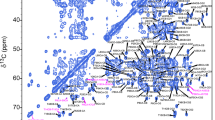Abstract
The 17 base pair operator O R 3 oligonucleotide, which is the preferential binding site for the Cro repressor of phage λ, was studied by two-dimensional NMR spectroscopy. A sequential assignment procedure based on two-dimensional Nuclear Overhauser Effect (NOESY) and scalar coupling correlated (COSY) NMR spectroscopy, together with the knowledge of the oligodesoxynucleotide sequence, made it possible to assign the non-exhangeable base protons and the H1′ and the H2′-H2″ sugar protons of the O R 3 operator DNA. The pattern of the observed NOE connectivities is consistent with a right-handed helical DNA structure. The base and sugar proton assignments provide the necessary information for further studies of the O R 3 operator — Cro repressor interaction.
Similar content being viewed by others
Abbreviations
- COSY:
-
correlated spectroscopy
- FID:
-
free induction decay
- NOE:
-
nuclear Overhauser effect
- NOESY:
-
nuclear Overhauser effect spectroscopy
- RD:
-
relaxation delay
- TSP:
-
sodium 3-trimethylsilyl-(2,2,3,3-2H4)propionate
- EDTA:
-
sodium ethylendiamine tetraacetate
References
Anderson WF, Ohlendorf DH, Takeda Y, Matthews BW (1981) Structure of the cro repressor from bacteriophage λ and its interaction with DNA. Nature 290:754–758
Aue WP, Bartholdi E, Ernst RR (1976) Two-dimensional spectroscopy. Application to nuclear magnetic resonance. J Chem Phys 64:2229–2246
Bax A, Freeman R (1981) Investigation of complex networks of spin-spin coupling by two-dimensional NMR. J Magn Res 44:542–563
Buck F, Hahn K-D, Zemann W, Rüterjans H, Scheek R, Kaptein R, Beyreuther K, Sadler JR, Chernov BK, Kirpichnikov MP (1984) NMR study of repressor — operator interactions. In: Zelinka J, Balan J (eds) Metabolism and enzymology of nucleic acids, vol 5:27–40. Slovac Academy of Sciences, Bratislava
Chou S-H, Hare DR, Wemmer DE, Reid BR (1983) Sequencespecific recognition of deoxyribonucleic acid. Chemical synthesis and nuclear magnetic resonance assignment of the imino protons of λ O R 3 operator deoxyribonucleic acid. Biochemistry 22:3037–3041
Clore GM, Gronenborn AM (1983) Sequence-dependent structural variations in two right-handed alternating pyrimidine-purine DNA oligomers in solution determined by nuclear Overhauser enhancement measurements. EMBO J 2:2109–2115
Clore GM, Gronenborn AM (1984) A nuclear-Overhauser-enhancement study of the solution structure of a double-stranded DNA undecamer comprising a portion of the specific target site for the cyclic-AMP-receptor protein in the gal operon. Eur J Biochem 141:119–129
Feigon J, Leupin W, Denny WA, Kearns DR (1983) Two-dimensional proton nuclear magnetic resonance investigation of the synthetic DNA decamer d(ATATCGATAT) 2. Biochemistry 22:5943–5951
Gurevich AZ, Barsukov IL, Arseniev AS, Bystrov VF (1984) Combined COSY-NOESY experiment. J Magn Res 56:471–478
Hare DR, Wemmer DE, Chou S-H, Drobuy G, Reid BR (1983) Assignment of the non-exchangeable proton resonances of d(C-G-C-G-A-A-T-T-C-G-C-G) using two-dimensional NMR methods. J Mol Biol 171:319–336
Hilbers CW (1979) Hydrogen-bonded proton exchange and its effect on NMR spectra of nucleic acids. In: Shulman RG (ed) Biological applications of magnetic resonance. Academic Press, New York, pp 1–43
Kirpichnikov MP, Hahn K-D, Buck F, Rüterjans H, Chernov BK, Kurochkin AV, Skryabin KG, Bayev AA (1984) 1HNMR study of the interaction of bacteriophage λ Cro protein with the O R 3 operator. Nucl Acids Res 12:3551–3561
Kurochkin AV, Chernov BK, Skryabin KG, Kirpichnikov MP, Bayev AA (1984) Interaction between Cro repressor and the model specific binding site. Dokl Akad Nauk SSSR 275:1213–1216 and unpublished results
Macura S, Huang Y, Suter D, Ernst RR (1981) Two-dimensional chemical exchange and cross-relaxation spectroscopy of coupled nuclear spins. J Magn Res 43:259–281
Matthews BW, Ohlendorf DH, Anderson WF, Takeda Y (1982) Structure of the DNA-binding region of lac repressor inferred from its homology with Cro repressor. Proc Natl Acad Sci USA 79:1428–1432
McKay DB, Steitz TA (1981) Structure of catabolite gene activator protein at 2.3 Å resolution suggests binding to lefthanded B-DNA. Nature 290:744–749
Noggle J, Schirmer RE (1971) The nuclear Overhauser effect-Chemical applications. Academic Press, New York
Ohlendorf DH, Anderson WF, Fisher RG, Takeda Y, Matthews BW (1982) The molecular basis of DNA-protein recognition inferred from the structure of cro repressor. Nature 298:718–723
Pabo CO, Lewis M (1982) The operator-binding domains of repressor: structure and DNA recognition. Nature 298:443–447
Ptitsyn OB, Finkelstein AV, Kirpichnikov MP, Skryabin KG (1982) cI and lex A repressors consist of three cro-like domains. FEBS Lett 147:11–15
Sauer RT, Yocum RR, Doolittle RF, Lewis M, Pabo CO (1982) Homology among DNA-binding proteins suggests use of a conserved super-secondary structure. Nature 298:447–451
Scheek RM, Russo N, Boelens R, Kaptein R (1983) Sequential resonance assignment in DNA 1H NMR spectra by two-dimensional NOE spectroscopy. J Am Chem Soc 105:2914–2916
Scheek R, Boelens R, Russo N, van Boom JH, Kaptein R (1984) Sequential resonance assignments in 1H NMR spectra of oligo nucleotides by two-dimensional NMR spectroscopy. Biochemistry 23:1317–1376
Takeda Y, Ohlendorf DH, Anderson WF, Matthews BW (1983) DNA-binding proteins. Science 221:1020–1026
Tran-Dinh T, Taboury J, Huynh-Dinh T, Renous S, Genissel B, Igolen J (1983) DNA fragment conformations. 1H NMR comparative studies of helix-coil transition and conformation of d(CACGTG) and d(GTGCAC). Eur J Biochem 133:579–589
Weiss MA, Patel DJ, Sauer RT, Karplus M (1984a) Two-dimensional 1H NMR study of the λ operator site O L 1: a sequential assignment strategy and its application. Proc Natl Acad Sci USA 81:130–134
Weiss MA, Patel DJ, Sauer RT, Karplus M (1984b) 1H NMR study of the λ operator site O L 1: assignment of the imino and adenine H2 resonances. Nucl Acids Res 12:4035–4047
Wider G, Macura S, Anil Kumar, Ernst RR, Wüthrich K (1984) Homonuclear two-dimensional 1H NMR of proteins. Experimental procedures. J Magn Res 56:207–234
Author information
Authors and Affiliations
Rights and permissions
About this article
Cite this article
Hahn, K.D., Buck, F., Rüterjans, H. et al. 1H NMR study of the interaction of bacteriophage λ Cro protein with the O R 3 operator. Eur Biophys J 12, 87–95 (1985). https://doi.org/10.1007/BF00260431
Received:
Accepted:
Issue Date:
DOI: https://doi.org/10.1007/BF00260431




